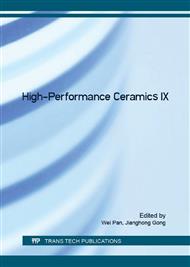p.404
p.409
p.414
p.419
p.423
p.428
p.433
p.437
p.441
Effect of Preparation Technology on Properties of Quartz Pore Gradient Materials Using Low-Grade Quartz Sand
Abstract:
The technology of quartz pore gradient ceramics were researched with the low grade quartz sand along the Yangtze River via the vacuum sintering method in this paper, which lay technology foundation for exploiting new heat insulating materials. The research results are shown as following, when the ratio of water to raw materials is 1, the shape and pore distribution of pore gradient ceramics is better. The porosity are first increased and then decreased with an increasing the sintering temperature. The suitable sintering temperature is decided at 1100°Cæ, the density is 1.343g/cm3, the porosity is 48.7%, the compressive strength is 7.071MPa, and the pore gradient structure is homogeneous transition zone.
Info:
Periodical:
Pages:
423-427
Citation:
Online since:
July 2016
Authors:
Price:
Сopyright:
© 2016 Trans Tech Publications Ltd. All Rights Reserved
Share:
Citation:


